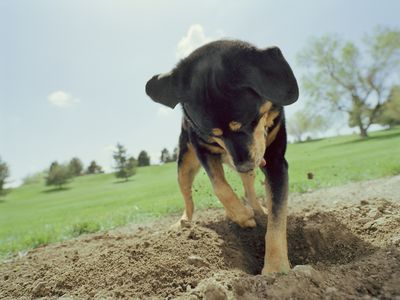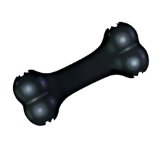Table of Contents
CAUSES | BREEDS | SOLUTIONS | PREVENTION | BROCHURES
"Dog digging behaviors can be corrected by channeling this natural self rewarding behavior to solutions that work for both your dog and yourself."
Digging is a normal behavior for dogs, but as a dog owner, you don't want your flowerbeds or yard dug up. In some cases, dogs try to dig under fences to escape the yard, and that can be more than a nuisance; it can prove dangerous for them if they are able to reach the street. Digging in the dirt (or eating the dirt for that matter) will not harm a dog. The only harm would be if the soil has toxins. Note that a dog that eats dirt could have a gastrointestinal problem (not caused by the dirt itself). To stop the behavior it would be helpful to understand any reason for the behavior so that behavioral modification techniques can be used.

Causes
The causes of canine digging behavior include:
- Breed predisposition
- Boredom: dogs that do not receive enough exercise might express themselves by digging to use pent up energy. Don't use negative reinforcement to address the problem (yelling) since this is a form of attention and will satisfy a dog that is looking for just that, some attention.
- Desire to escape under a fence: in this case does your dog have other escape oriented behaviors such as scratching at a door when in the house. This behavior is associated with separation anxiety.
- Going toward a female dog in heat
- Behavioral thermoregulation: in warm climates or on warm days a dog might dig a hole and lie in it to cool down (common in Huskies). Providing an alternative to digging such as a child's wadding pool might help.
- Predatory behavior: dogs like to chase mice, voles, moles or gophers. They might also go after burrowing insects (they follow the sound).
- Mimicking human behavior: if an owner digs, a dog might exhibit the same behavior
- To bury something based on instinct: dogs that bury something such as a bone or toy is similar to the behavior of rodents that hide food in the ground or holes for later use or consumption.
Breeds Dependent Reasons for Dog Digging
Many dog breeds are predisposed to dig as a natural behavior.
- Dogs with Heavy Coats: Dogs such as sled dogs and chow chows want to dig areas in the dirt where they could keep cool.
- Earth Dogs: These dogs have a predisposition to dig tunnels to catch small animals such as gophers.
- Earth dogs: Several breeds have been bred to tunnel under ground to catch small animals such as gophers. These breeds are terriers and dachshunds.
- Other breeds have been trained to follow a scent and dig for prey. Breeds that are trained to follow a scent include hounds (beagles, bassets and coon hounds).
Solutions for Dog Behavior Digging
Fortunately, there are things that can be done to discourage dog behavior digging.
- If you find your dog digging, say "No!" in a firm voice. Take him away from the spot where he is digging. Don't give him excessive attention, though, or you will reinforce the behavior. Consider using a shake can along with the "no." This is effective when the dog digs right in front of you.
- Don't scold your dog after the fact. He won't understand what he's being scolded for.
- Some dogs dig for entertainment. Make sure to provide toys for your dog if he is going to spend much time in the yard alone. Rotate his toys to keep them interesting.
- Very active dogs will dig just for the activity. Try walking your dog twice a day and playing games like fetch or Frisbee.
- Dogs need to keep their minds active, as well. Try teaching your dog commands and tricks. You can also give your dog toys that have hiding places for treats. Your dog has to figure out how to get the treats out of the hiding places.
Dog behavior digging can be replaced with other activities such as those encouraged with a Kong Toy which uses hidden food to keep a dog busy and engaged for hours.
- If they are hot, dogs will often dig so that they can lie in the cool dirt. If your dog is going to be outside in hot weather, make sure there is a cool place for him to rest such as an air conditioned area. Also make sure there is fresh water in a bowl that will not tip over.
- If your dog is digging under the fence, try putting wire mesh under the fence in the area where he is digging. Dogs who have not been neutered may try to escape the yard to find a mate, so make sure you get your pet neutered if you do not plan to breed him.
- Remove the reason why your dog is digging. For example call an exterminator to remove any animals from the yard such as gophers.
- Some dogs just have to dig, particularly dogs that have been bred to hunt prey. If your dog is determined to dig, create an acceptable digging area in your yard. Place loose soil or sand in that area. If you find your dog digging in another area, say "No!" in a firm voice and lead him to his digging area. Praise him for digging in the appropriate area. Keep your dog inside until you are ready to allow him or her to dig. Then lead your dog to the digging area. Provide treats when digging occurs in an acceptable area.
Wooden Stake Method
If you dog digs holes when you are not around, the consider using the wooden stake method. In this approach, stake a piece of wood in the middle of the hole. Dig around the stake a bit to make the dirt smell fresh. Put your dog on a leash and time him or her to the stake. Leave your dog in place for 20 minutes. reappear every 10 minutes and shake a shake can* while at the same time say "no." After 20 minutes, untie your dog, but leave the stake in the ground. This will remind your dog about the negative consequences of the behavior. Do the same for each hole that was dug. Eventually your dog will associate digging with a negative reaction from you.
A shake can is a training aide that can be used to correct many types of training issues. Cree ate your own with an empty soda can filled with 20 pennies and tape the hole closed. Shake the can when saying the word "no."
Prevention
To prevent the behavior one approach is to make digging less enticing. Consider putting a layer of chicken wire under a layer of soil, a particularly effective method if trying to protect a flower bed. Another approach, as mentioned above is to provide a dog with their own digging area. Put a bone or rawhide in the designated area to encourage digging.
Another alternative is to provide a dog toy or puzzle that provides a dog with the digging they need. Last, you can divert the dog by playing catch or other games.
For Additional Reading
References for Dog Behavior Digging
Dog Behavior Digging Researched by: Jeff Grill

